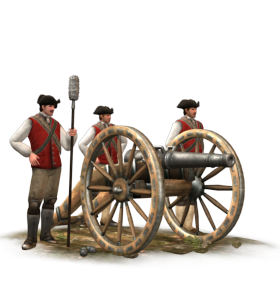Difference between revisions of "12-lber Foot Artillery (ETW Unit)"
Tango12345 (talk | contribs) (→Factions) |
Tango12345 (talk | contribs) (→Factions) |
||
| Line 44: | Line 44: | ||
*[[Image:Portugal_flagetw.png|25px]] [[Portugal (ETW Faction)|Portugal]] | *[[Image:Portugal_flagetw.png|25px]] [[Portugal (ETW Faction)|Portugal]] | ||
*[[Image:Prussia_flag.jpg|25px]] [[Prussia (ETW Faction)|Prussia]] | *[[Image:Prussia_flag.jpg|25px]] [[Prussia (ETW Faction)|Prussia]] | ||
| − | *[[Image:Quebec. | + | *[[Image:Quebec.jpg|25px]] [[Quebec (ETW Faction)|Quebec]] |
*[[Image:Russia_flag.jpg|25px]] [[Russia (ETW Faction)|Russia]] | *[[Image:Russia_flag.jpg|25px]] [[Russia (ETW Faction)|Russia]] | ||
*[[Image:Saxony_flag.jpg|25px]] [[Saxony (ETW Faction)|Saxony]] | *[[Image:Saxony_flag.jpg|25px]] [[Saxony (ETW Faction)|Saxony]] | ||
Revision as of 07:32, 18 September 2011
Overview
Despite the name, foot artillery batteries are towed by horses, not men. The artillerymen march alongside their pieces. All guns are smooth-bore, and rated by the size or weight of solid projectile that they fire: a 12-pounder is so called because it hurls a cannonball weighing 12 pounds towards the enemy! It may not do so very accurately, as the casting of barrels and balls means that there is inevitably a gap (wind-age) between a shot and the barrel sides. This means that a cannonball rattles down the barrel when fired, leading to an inherent inaccuracy. As technology advances, other types of ammunition can be fired.
Historically, there was limited standardization between guns, even in the same battery. Parts from one gun would not always fit a sister piece. A gunner would know the quirks of his own weapon intimately. Cunningly, the French attempted to develop a system of interchangeable components for all their guns and field equipment. Jean Baptiste Vaquette de Gribeauval (1715-1789), the inspector of artillery, tried but he wasn’t entirely successful. Even after he had finished there were still more than 20 different types of wheel in use!
Tactics
12-pounders are the first mobile artillery available to almost every faction and, for some time, is the heaviest piece of artillery available. Despite the fact that they can move, 12-pounders should ideally reposition as little as possible, as it takes time to limber and unlimber the cannons and their movement speed is agonizingly slow. Until 24-pounders become available, 12-pounders are the best artillery to use in the front lines, delivering the heaviest payloads.
24-pounders are an improvement over 12-pounders, with no additional weaknesses. Therefore, 12-pounders should be replaced completely by 24-pounders when they become available.
Factions
 Great Britain
Great Britain United Provinces
United Provinces Afghanistan
Afghanistan Austria
Austria Bavaria
Bavaria Dagestan
Dagestan Gran Colombia
Gran Colombia Courland
Courland Denmark
Denmark France
France Genoa
Genoa Georgia
Georgia Greece
Greece Hannover
Hannover Hessen
Hessen Hungary
Hungary Ireland
Ireland Knights of St. John
Knights of St. John Louisiana
Louisiana Maratha Confederacy
Maratha Confederacy Mexico
Mexico Mysore
Mysore Naples & Sicily
Naples & Sicily New Spain
New Spain Norway
Norway Italian States
Italian States Savoy
Savoy Poland-Lithuania
Poland-Lithuania Portugal
Portugal Prussia
Prussia Quebec
Quebec Russia
Russia Saxony
Saxony Scotland
Scotland Spain
Spain Sweden
Sweden Thirteen Colonies
Thirteen Colonies United States
United States Venice
Venice Westphalia
Westphalia Württemberg
Württemberg
